There’s a moment when something shifts—not necessarily because what came before was bad, but because we realize there’s a better way. It’s not about rejection; it’s about evolution. Traditional braces have shaped smiles, correcting misalignments and transforming bites for years. But now, Invisalign® offers an alternative—one that’s nearly invisible, removable, and designed for comfort. Can Invisalign replace braces? The question isn’t whether braces have worked; it’s whether we’re looking at something that can do the job differently, perhaps even better. Change isn’t just about convenience. It’s about expanding possibility. It’s about realizing that while something may have served us well, there’s room for growth—room to ask, what if this could be even better?
For many of us, it’s easy to resist change, to feel nostalgic for what once was. Yet, every innovation that takes over does so for a reason. Not because we were wrong to rely on the old ways but because progress has a way of showing us what we didn’t know we needed.
Is Invisalign as Effective as Braces?
At first glance, it’s easy to be skeptical. How could a thin, clear piece of plastic possibly move teeth the way traditional braces do? After all, metal brackets and wires have long been the standard for realigning smiles. But Invisalign® isn’t just any plastic—it’s a precisely engineered material designed for one purpose: controlled, predictable tooth movement.
Invisalign aligners are made from SmartTrack®, a specialized thermoplastic that’s far more advanced than it looks. Unlike ordinary plastics, SmartTrack is a multilayer blend of thermoplastic polyurethane resin—a combination that gives it strength, flexibility, and a unique ability to apply continuous pressure on teeth.
Why Does This Matter?
- Durability: SmartTrack resists cracking and warping, ensuring that each aligner holds its shape and remains effective throughout the treatment. Unlike softer plastics that might bend or weaken over time, this material is built to last.
- Elastic recovery: One of its biggest advantages is its ability to snap back to its original form. This controlled elasticity helps maintain gentle but steady pressure on teeth, guiding them into place with precision.
- Consistent force application: Unlike earlier clear aligner materials, SmartTrack delivers forces more evenly, allowing for predictable movement. This means fewer surprises and a smoother treatment process.
- Flexibility without weakness: Though strong, the material is still flexible enough to make aligners easy to remove and reinsert without losing their fit.
So, while it may look like a simple plastic tray, Invisalign is the result of advanced material science designed to move teeth efficiently and comfortably. The real power isn’t just in what it’s made of, but in how it works. They apply precise, controlled forces that guide your teeth into place, one aligner at a time.
Can Invisalign Replace Braces?
Invisalign® is a powerful tool for straightening teeth, but whether it can fully replace braces depends on the complexity of the case. While both treatments work toward the same goal, they each have strengths that make them more suitable for different orthodontic needs.
When Invisalign Works Just as Well as Braces
For mild to moderately crooked teeth, small gaps, and minor bite issues, Invisalign® can be just as effective as traditional braces. The clear aligners apply consistent, gentle pressure to shift teeth into alignment, making them a great choice for:
- Mild to moderate crowding or spacing: If your teeth are slightly misaligned or have small gaps, Invisalign can gradually bring them into place.
- Minor bite issues: Slight overbites, underbites, and crossbites can often be corrected with clear aligners.
- Fully developed teeth: Invisalign works best for teens and adults whose teeth and jaws have stopped growing. It allows for predictable movement.
In these cases, Invisalign provides a discreet, comfortable alternative to braces without sacrificing effectiveness.
When Braces Are the Better Choice
More complex orthodontic challenges require more control than clear aligners can provide. Braces are the better option when dealing with:
- Severe misalignment: Teeth that are significantly crowded, twisted, or overlapping need the stronger, continuous force that braces offer.
- Major bite issues: Large overbites, underbites, crossbites, and open bites require precise, targeted pressure that aligners may not fully achieve.
- Jaw alignment concerns: Braces, sometimes combined with additional appliances, can guide jaw development in ways Invisalign cannot.
Braces remain fixed to your teeth, which means they’re always working—no need to worry about remembering to wear them. Their design allows orthodontists to make detailed adjustments, applying stronger pressure where needed to achieve precise movements that clear aligners may struggle with.
So, can Invisalign replace braces? For many cases, yes—but not all. The best treatment depends on your specific dental needs.
Can Invisalign Replace Braces? Find Out Which Option Is Right for You!
Choosing between Invisalign® and braces isn’t just about aesthetics—it’s about finding the best solution for your unique smile. Whether you’re looking for a discreet way to straighten your teeth or need the strength of traditional braces for more complex adjustments, the right treatment is the one that works for you. Contact us today to schedule a free consultation, understand your options, and determine the best path forward.
Follow us on Facebook and Instagram to learn more about clear aligners and see how they’re transforming smiles every day.

